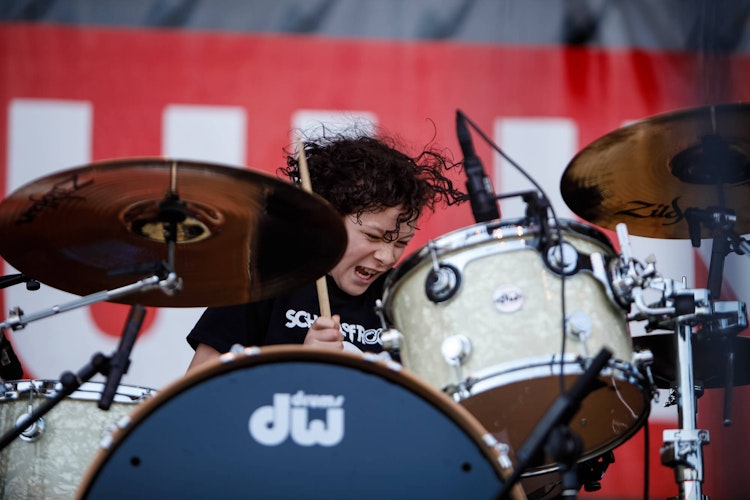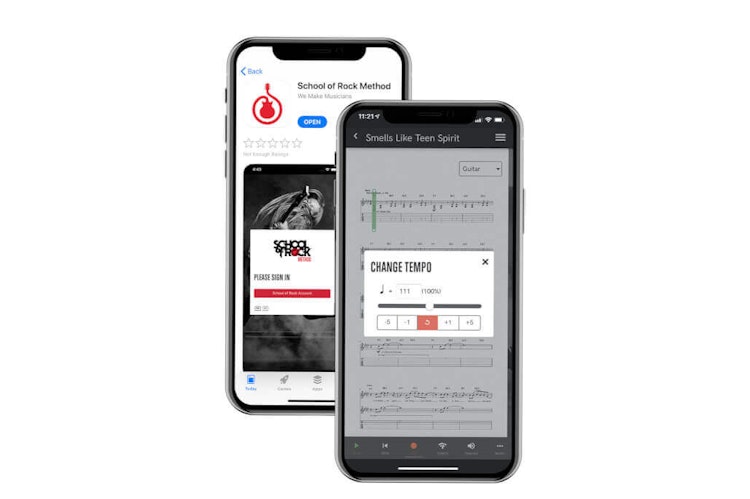Drum notation is a form of writing down music specific to percussion instruments. It’s quick and easy to learn. Think of it as a language for drums. If you know how to read and write drum notation, then you know how to communicate musically with others.
To read drum notation, you need to learn the different symbols. These symbols tell you what part of the drum set to play and when. By learning how to read drum notation, you’ll be able to quickly play a rhythm or drum beat, even if you’ve never heard it before.
WHAT IS DRUM NOTATION?
Drum notation is different than sheet music, although they look similar and use some of the same concepts. In sheet music, the symbols on the staff correspond to different notes. In drum notation, the symbols represent different parts of the drum set (snare, hi-hat, bass drum, etc.) to be played. This is useful for beginners learning to coordinate their limbs, helping to develop the necessary skill sets to both comfortably keep steady time and play the correct part of the drum set.
In drum notation, the symbols represent different parts of the drum set
In drum notation, the notes are written on the staff and are separated by vertical bar lines. The space between the bar lines is referred to as a “measure.” You will typically count beats while playing different notes on the drum set within each measure.
Drum notation does contain similarities to sheet music in that measures are counted and read the same way. By learning to read and write this part of the musical language, you’ll develop a strong sense of timing and rhythm control.
How to read drum notation
Like the English language, drum notation is read from left to right. The staff is made up of five lines and four spaces, but notes can be positioned above or below the staff as well. Notes are placed in the staff based on which part of the drum set should be played at any given time. Notice below that the bass drum is in a different position on the staff than the snare or ride cymbal.
Drums are notated by dots, while cymbals are notated with an “x.” These symbols typically have “stems” attached to them, which help explain how to count the beat that is shown.
Reading drum notation
There are several symbols musicians should know when starting to read drum notation, especially if they’re just starting off with a four- or five-piece drum set.
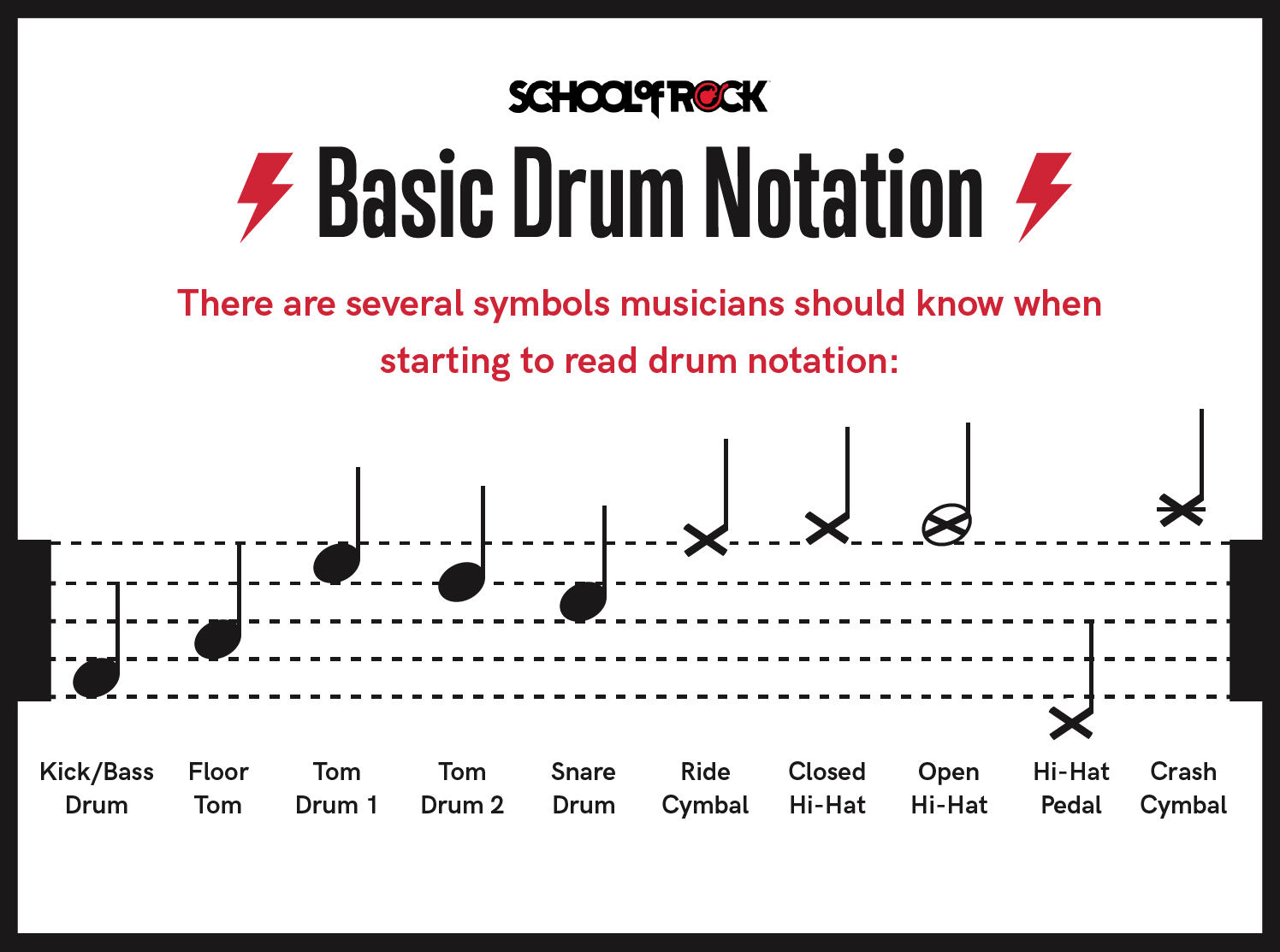
- Bass. Notation for the bass drum sits in the bottom space of the staff. The bass drum is typically the biggest drum on the drum set, and usually produces the lowest note. It is used with a foot pedal and is often referred to as the “kick drum.”
- Floor tom. Notation for the floor tom sits in the third space from the top of the staff. The floor tom (or low tom) is typically the next lowest note on the drum set. It is often referred to as a floor tom because it may rest on the floor by using legs.
- Tom 1 and tom 2. Toms are notated on the first space from the top of the staff and the line below that space. Sometimes called the high tom, this drum typically produces a note higher than both the floor tom and bass drum. Many drum fills are started on this drum, and many drum sets have more than one tom.
- Snare. The snare drum is often considered to be the main drum of the drum set. Its notation is located in the second space from the top of the staff. Many drum beats are based around the pattern between the bass drum and snare drum. It gets its famous snare sound from the snare wires that are attached to the bottom head of the drum.
- Ride. This cymbal is often the biggest on a drum kit and is used for many different purposes. The ride cymbal is often tapped with the tip of the stick to create a feeling of “riding,” but it can also be used as a crash cymbal. On the staff it’s located on the very top line.
- Hi-hat. The hi-hat notation sits above the top line on the staff, and is often a main time-keeping tool. The hi-hat is a pair of cymbals that are used with a unique type of stand that contains a foot pedal. Drummers can control the type of note that’s produced by stepping on the hi-hat pedal and tightening the two cymbals together and then striking them, known as closed hi-hat, or letting them lightly bounce off of each other by releasing pressure with the foot, known as open hi-hat.
- Crash 1 and crash 2. A crash cymbal is a very loud, big cymbal that is often used to accent different rhythms within music. Crash cymbals vary in size and tone and contain a large number of different styles and sounds. This cymbal differs from the others on the drum set because it’s often struck with force and can help elevate the dynamic movements of a piece of music. Its notation is located above the hi-hat, above the top line on the staff. On drum sets with two crash cymbals, the second crash will be notated in the space above the first crash.
Reading the music staff for drums
Music is often divided up into even (or sometimes odd) groups of space. We use “measures” in music to organize the rhythms of the song into these repeated groupings to make it easier to count through a song. To communicate what grouping we should count, we use what’s called a time signature.
Reading time signatures
A time signature contains two numbers displayed as a fraction. The top number tells you how many beats to count within one measure, and the bottom number tells you what type of note gets the beat (quarter notes, eighth notes, etc). Think of the time signature as ruler. You’re measuring time, or more accurately, the space between the notes that you’re playing.
For example, a quarter note in a 4/4 time signature represents one beat, meaning you strike the drum once per beat. And a whole note in a 4/4 time signature represents four beats, meaning you strike the drum once every four beats.
Some of the most common drum beats are whole notes, half notes, quarter notes, eighth notes, sixteenth notes, and thirty-second notes. There are different types of triplets that can be played as well, where you play three notes in the space normally occupied by two notes.
Reading repeat signs
A repeat sign tells you to do just what it sounds like: repeat a pattern. That being said, there are several different repeat signs to understand in drum notation.
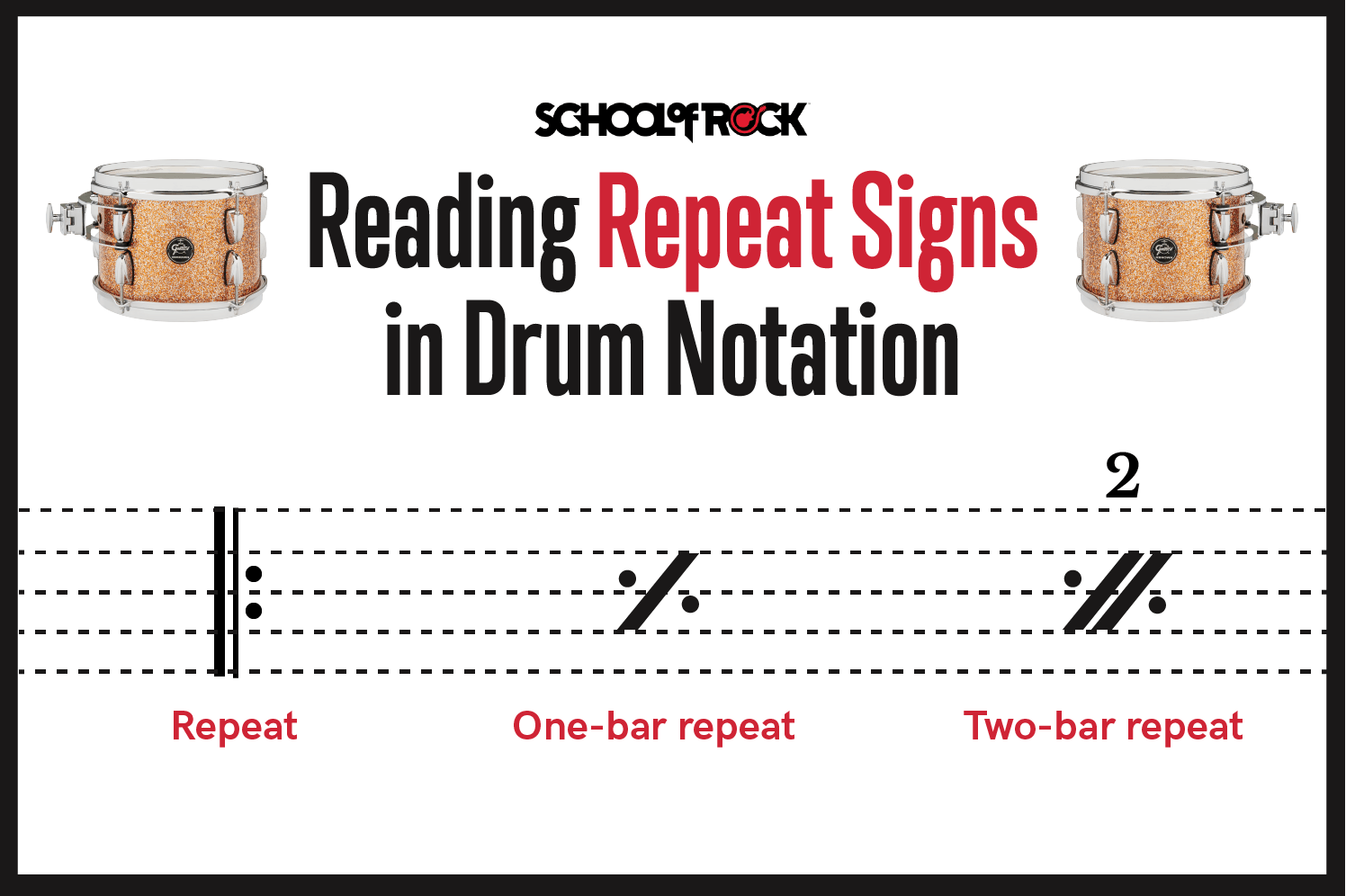
- Repeat sign. Many drum parts are played in patterns, meaning they’re played more than once or twice in a row. In drum notation, a repeat sign tells the drummer to return to the beginning of the section and play the same part again.
- One-bar repeat sign. A one-bar repeat sign looks similar to the symbol that represents the percent sign. You’ll see two dots, one on each side of a diagonal line. The one-bar repeat sign means to repeat the previous measure for an additional measure and then continue on in the music.
- Two-bar repeat sign. The two-bar repeat sign means to repeat the previous two measures and then continue. It looks the same as a one-bar repeat sign but has two lines instead of one. You may often see the number 2 written above the symbol.
Get realtime performance feedback
You don't have to practice the drums on your own. With the School of Rock Method app, you can receive realtime feedback on every beat, rim-click, and crash.
Check out the School of Rock Method
How is drum notation different from drum tablature?
Drum tab notation is a simplified version of drum notation. Instead of using the typical notes you would read in a piece of music, drum tablature uses a series of vertical and horizontal lines with different characters to represent rhythm and patterns for the drummer to play. All drummers are different and learn in different ways.
New drummers can benefit from using drum tab notation to begin learning the basics, almost as a steppingstone to drum notation. However, drum tablature is complicated in its own right and is largely a relic of a time when computers could not easily support the layout of drum notation.
Knowing how to hit the drums
You can play each drum in a variety of ways. Each gives you a different result. Drummers are responsible for both tempo control (speed) and dynamic control (this is sometimes referred to as volume control, or feel control). There are different types of symbols used to tell the drummer how hard or soft to play, or in what way.
Striking the drums
There are multiple ways to strike a drum, depending upon the type of grip you’re using. How you grip the sticks determines how the drum will sound when you hit it. You can use a tight or loose grip, and can play using different grip types, such as traditional or matched grip. Be sure to hold the sticks in the correct position and to balance them in your hands comfortably.
You don’t always need to strike hard to draw out volume on a drum set; drums are naturally loud. You can use your thumb and index finger to control the stick while using the other fingers to balance out the motion of the stroke.
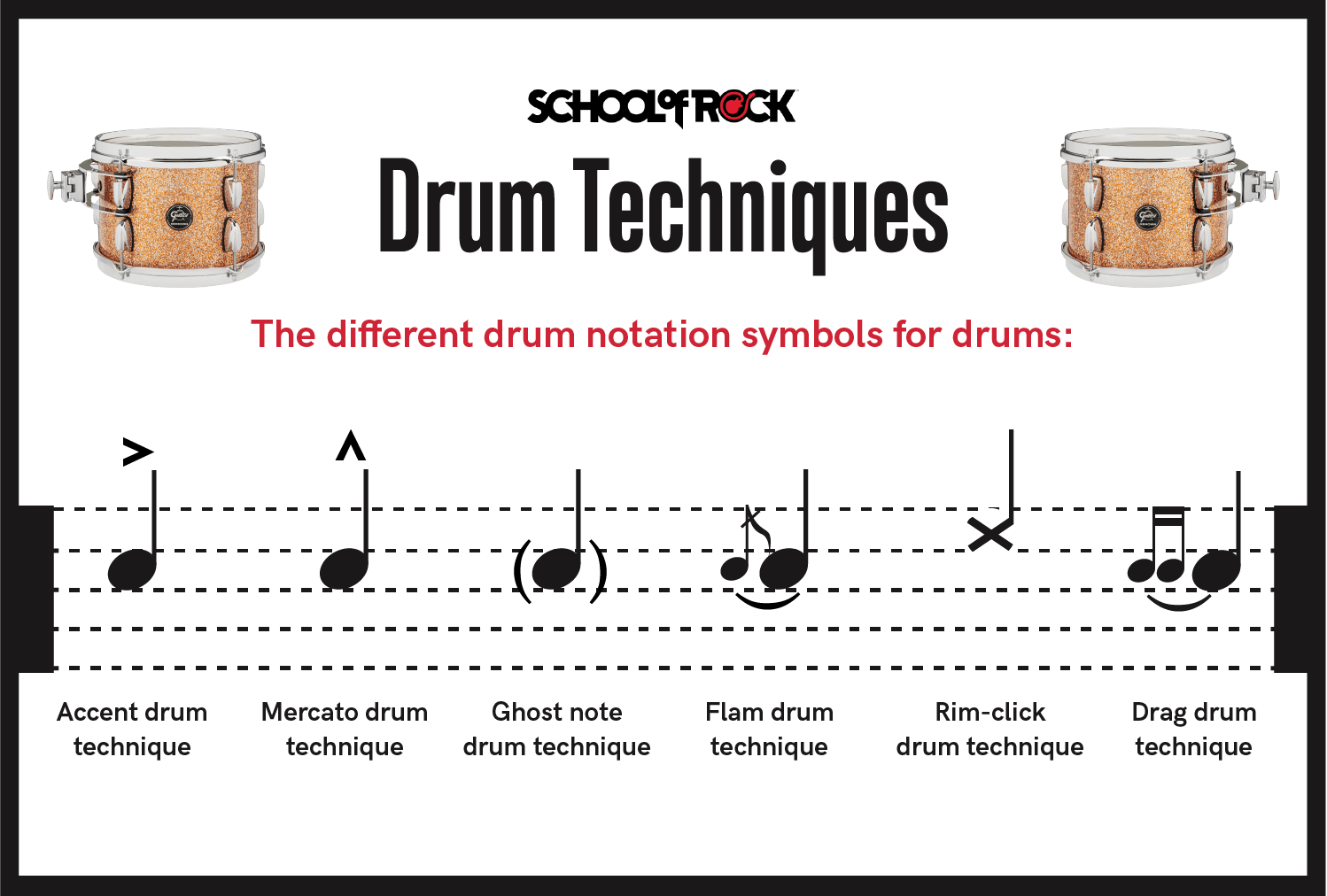
What is an accent drum technique?
Drummers have the ability to “accent” different parts of rhythms by making certain notes sound louder, softer, lower, or higher, or by using a different part of the drum set.
An example of an accent is when the drummer opens the hi-hat during a drum beat and strikes it, and then presses back down on the foot pedal to close it, creating an open-and-closed-sounding rhythm. The accent symbol is usually located directly above the note being accented.
What is a marcato drum technique?
A marcato technique is represented by one note being played more loudly or more forcefully than others surrounding it. This is a good way to accent notes in a drum beat. It’s displayed as a vertical wedge above the intended note written on the page.
What is a ghost note drum technique?
Ghost notes are often played as light, bouncy notes on a snare drum that can sound like many quick notes played in succession. This technique is often used in drum beats to help create more rhythmic movements within a piece of music, and can be played with both the right and left hands.
What is a flam drum technique?
A flam note is created when a drummer strikes a drum with both hands simultaneously while placing the notes slightly apart from each other. It sounds like two notes, but they’re very close together and feel like one note.
What is a drag drum technique?
A basic drag rudiment is played by having one hand quickly strike two notes on the drum, followed by a single stroke with the other hand. When played tightly and quickly, you will get three notes that sound close together. Accent the final note in the drag rudiment to create a “completed” sound.
What is a rim-click drum technique?
A rim-click, or cross-stick, technique is employed when the drummer places the stick across the drum and taps the rim. You can strike the rim using the shoulder of the stick or can even turn the stick around and use the bottom side. Each gives a different sound. This technique is often used in soft, quiet pieces of music.
Knowing how to hit cymbals
When setting up your drum set, you have many options for selecting your cymbals. Depending on what you play, you may encounter any of the following techniques while reading drum notation.
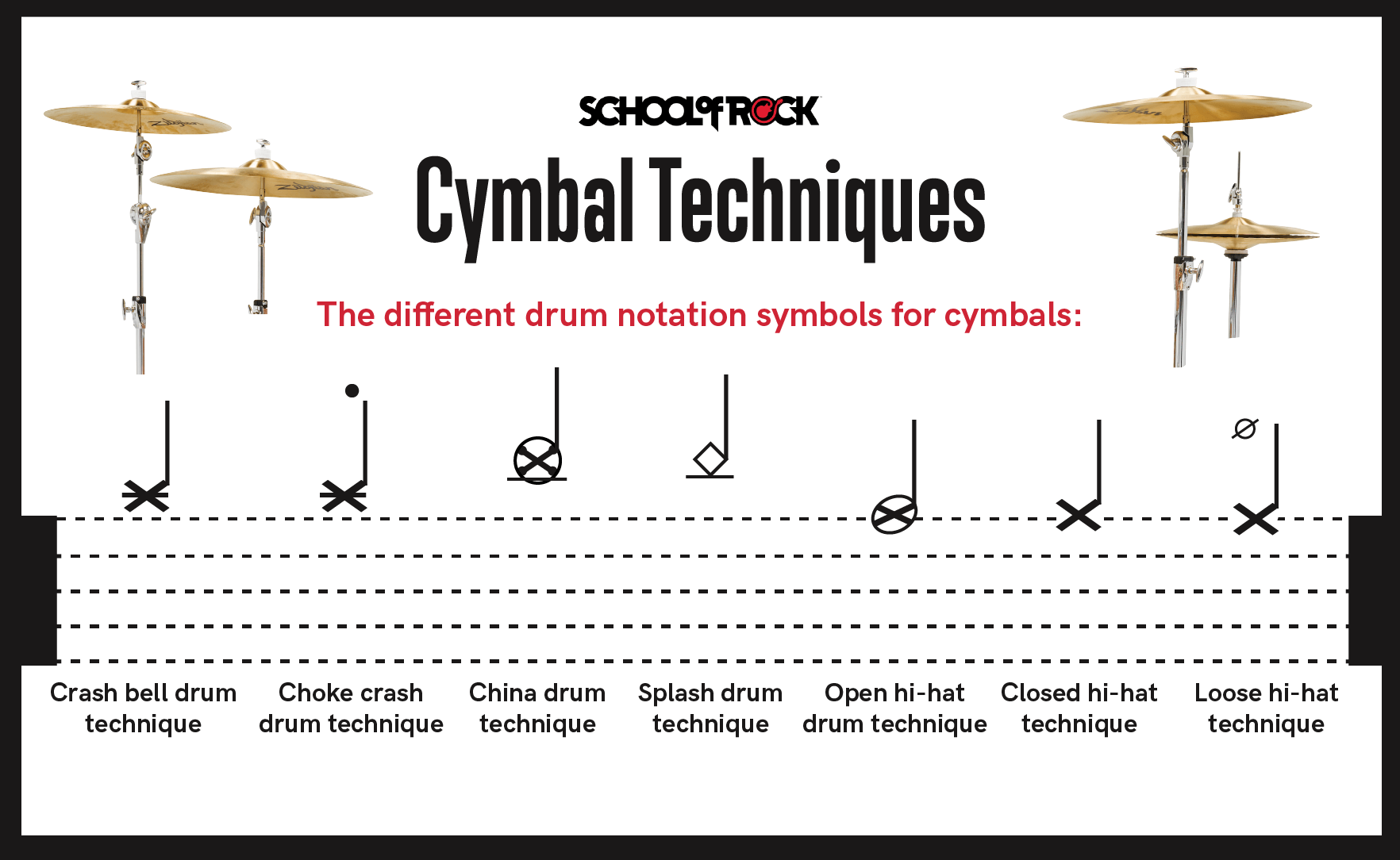
Striking the cymbal or hi-hat
The hi-hat is one of the main time-keeping tools for a drummer. By pressing your foot down on the pedal, you can create a tight sound between the two cymbals. The more you release pressure on the pedal, the more of a “washy” sound your hi-hat will make.
What is a crash bell drum technique?
You can use the bell of a cymbal to accent a part more loudly. Drummers often use the shoulder of the drum stick to bring out the volume of the bell.
What is a choke crash drum technique?
A choke crash technique is used when muting a cymbal after it’s been hit. This often creates a “tight” feel in music if performed alongside different instruments. To do this, you will first strike the cymbal (often a crash cymbal) as normal and then immediately grab it with one of your hands to quickly reduce its sound.
What is a china drum technique?
A china cymbal is often used as an alternative to a loud crash cymbal. It sounds very heavy and “trashy.” This cymbal can be used to accent loud sections in a piece of music.
What is a splash drum technique?
A splash cymbal is a very small cymbal used to accent light sections in a piece of music. Because of its small size, the notes don’t last as long as those of a ride or crash cymbal. Therefore this cymbal can be used to add a lot of versatility to lighter dynamic sections in music.
What is an open hi-hat drum technique?
An open hi-hat is often played by taking your foot off the hi-hat pedal and allowing the cymbals to bounce off each other. This is typically used in loud sections of music.
What is a closed hi-hat drum technique?
A closed hi-hat technique is the opposite of an open hi-hat: The two cymbals are tightly pressed against each other by pressing down on the foot pedal to create a very tight, crisp sound.
What is a loose hi-hat drum technique?
A loose hi-hat technique is in between a closed and open technique. You will typically press down lightly on the foot pedal, allowing the two cymbals to bounce off each other, but not so much that they resonate for a long time. You can use this technique to create a louder dynamic within a piece of music.
Play drums in real performances onstage
Our music programs are taught by practicing musicians with the experience you need to learn to play. Perform live shows and develop your skills in a supportive learning environment for all skill levels.
Learn tp play
Other drum techniques
When it comes to playing the drums, the sky's the limit. These are only a small sample of the many drum techniques you make encounter while reading drum notation.
What are soft one-handed rolls?
A soft one-handed roll is played by lightly striking the drum and then letting the bottom of the stick rest against the rim, followed by bouncing the stick back toward the drum to get a second stroke. This technique can be used to achieve more notes quickly with one hand.
What are accented one-handed rolls?
An accented one-handed roll is the same as the above but contains an accent with one of the notes. You can strike either of the two notes more loudly or softly than the other to create a unique rhythm.
Tips for Beginning to Read Drum Notation
When starting to read drum notes, it’s important to consider the following helpful tips to ensure you meet success.
1. Break the lesson down into smaller pieces.
When learning a new song on drums, divide its sections into unique groups and work on them one at a time. Then connect them together. This trick will help you memorize the parts of the song more quickly.
2. Take it slow.
New drummers need to develop coordination between their limbs. Learning drums is just as much of a mental challenge as it is a physical challenge. A good method for new drummers is to practice rudiments and paradiddles taught in our drum lessons so that you can learn different patterns of right and left strokes on the drums.
Much like learning how to play a video game for the first time, your brain needs to learn right and left striking patterns. This can take time, so patience is important.
3. Set time aside to practice every day.
Beginner drummers need to train their brains to use their limbs in new ways. Setting aside time every day to practice will help reinforce good habits and lead to more consistent improvement than doing longer, less-frequent practice sessions.
4. Consider drum notation software.
Drum notation software is a helpful tool when learning how to read and write music. As you learn the language, consider using different applications to help you grasp new concepts behind the drums set. A metronome is also a necessary tool for new drummers to help locate the beat and keep steady time. Tempo control will improve tremendously when a metronome is used in students’ practice routines.
5. Use words to make rhythms easier.
For beginners, learning to read drum notation is a lot like learning a new language. Use associations early on to remember what certain things mean on the drums. For example, certain words contain syllables that are applicable to different rhythms.
- The word “pizza” can be used to remember how to play eighth notes.
- The word “cheese” can represent quarter notes.
- “Pepperoni” can be used for sixteenth notes,
- “anchovy” for triplets, etc.
Ready to get started?
Now that you know the basics of how to read drum notation for beginners, how to tell the difference between it and drum tab notation, and some fundamental drum techniques, you’re ready to start playing. From beginner to advanced, School of Rock has taught thousands of students how to play drums and reach their full potential. Our instructors have the knowledge and experience to have you quickly playing your favorite rock songs onstage.
School of Rock students also gain access to a wealth of information, including our Method Books and Method App, which are utilized by our qualified instructors to teach a complete music education in a fun way.



